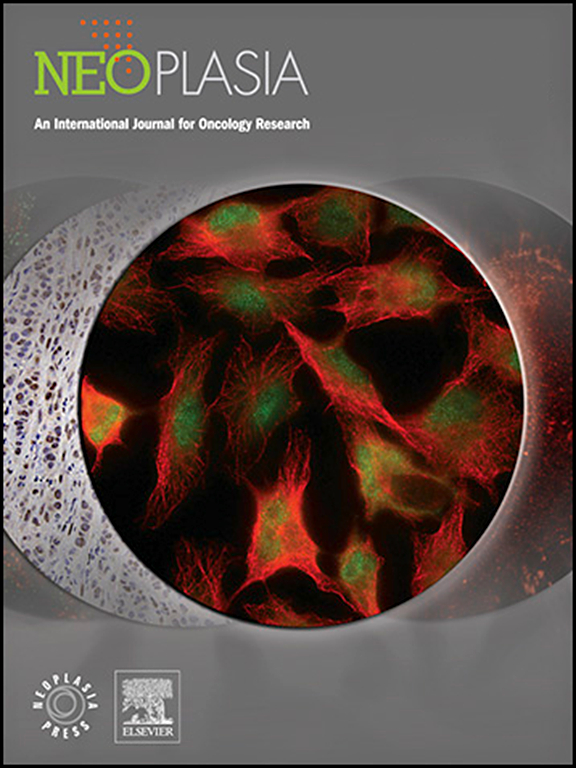Hepatocellular carcinoma escapes immune surveillance through deceiving thymus into recalling peripheral activated CD8+ T cells
IF 7.7
2区 医学
Q1 Biochemistry, Genetics and Molecular Biology
引用次数: 0
Abstract
The role of thymic epithelial cells (TECs) in eliminating self-reactive T cells through the presentation of self-antigens is well-established. However, it remains unclear whether TECs can eliminate tumor-reactive CD8+ T cells by presenting tumor antigens. In this study, we observed that CD73+ Granzyme B+ peripheral activated CD8+ T cells undergo apoptosis in the medullary region of the thymus in DEN-CCL4-induced spontaneous HCC mice, but not in the naïve control group. Mechanistically, HCC cells manipulate the thymus to recruit peripheral activated CD8+ T cells through the CCL19/CCL21-CCR7 axis. Additionally, TECs capture antigens from HCC cells for subsequent antigen presentation instead of de novo expressing tumor antigens. When tumor-associated CD8+ T cells homing to the thymus recognize the same tumor antigen presented by TECs, activation-induced cell death (AICD) is initiated in these T cells. Thymectomy redistributes CD8+ T cells into the tumor focus to suppress HCC growth. Alternatively, both inhibiting CCL19/CCL21 expression of thymic cells using an AMPK activator and blocking CCR7 on CD8+ T cells binding with ligands using Cmp2105 significantly reduces tumor-educated thymus dependent immune evasion. Our findings collectively demonstrate that HCC manipulates the thymus to trigger immune escape; pharmacologically targeting CCL19/CCL21-CCR7 axis to inhibit thymus homing can increase CD8+ T cells in the tumor microenvironment.

肝细胞癌通过欺骗胸腺召回外周活化的CD8+ T细胞来逃避免疫监视
胸腺上皮细胞(TECs)通过呈递自身抗原来消除自身反应性T细胞的作用已得到证实。然而,目前尚不清楚TECs是否可以通过呈递肿瘤抗原来消除肿瘤反应性CD8+ T细胞。在本研究中,我们观察到CD73+颗粒酶B+外周活化的CD8+ T细胞在den - ccl4诱导的自发性HCC小鼠胸腺髓质区发生凋亡,但在naïve对照组中没有。机制上,HCC细胞通过CCL19/CCL21-CCR7轴操纵胸腺募集外周活化的CD8+ T细胞。此外,tec从HCC细胞中捕获抗原用于随后的抗原呈递,而不是从头表达肿瘤抗原。当归巢到胸腺的肿瘤相关CD8+ T细胞识别由TECs呈递的相同肿瘤抗原时,激活诱导细胞死亡(AICD)在这些T细胞中启动。胸腺切除术将CD8+ T细胞重新分配到肿瘤病灶以抑制HCC的生长。另外,使用AMPK激活剂抑制胸腺细胞CCL19/CCL21的表达,以及使用Cmp2105阻断CD8+ T细胞上与配体结合的CCR7,均可显著减少肿瘤诱导的胸腺依赖性免疫逃避。我们的研究结果共同表明,HCC操纵胸腺触发免疫逃逸;药理学上靶向CCL19/CCL21-CCR7轴抑制胸腺归巢可增加肿瘤微环境中的CD8+ T细胞。
本文章由计算机程序翻译,如有差异,请以英文原文为准。
求助全文
约1分钟内获得全文
求助全文
来源期刊

Neoplasia
医学-肿瘤学
CiteScore
9.20
自引率
2.10%
发文量
82
审稿时长
26 days
期刊介绍:
Neoplasia publishes the results of novel investigations in all areas of oncology research. The title Neoplasia was chosen to convey the journal’s breadth, which encompasses the traditional disciplines of cancer research as well as emerging fields and interdisciplinary investigations. Neoplasia is interested in studies describing new molecular and genetic findings relating to the neoplastic phenotype and in laboratory and clinical studies demonstrating creative applications of advances in the basic sciences to risk assessment, prognostic indications, detection, diagnosis, and treatment. In addition to regular Research Reports, Neoplasia also publishes Reviews and Meeting Reports. Neoplasia is committed to ensuring a thorough, fair, and rapid review and publication schedule to further its mission of serving both the scientific and clinical communities by disseminating important data and ideas in cancer research.
 求助内容:
求助内容: 应助结果提醒方式:
应助结果提醒方式:


